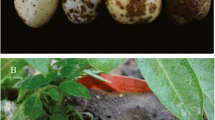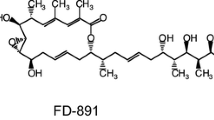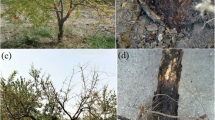Abstract
By use of a tyrosine-casinate-nitrate medium,Streptomyces atroolivaceous, S. cinerochromogenes, S. corchorusii, S. diastatochromogenes, S. lydicus, S. malachiticus, and three unidentifiedStreptomyces spp. were isolated from deep-pitted scab lesions on potato cultivars Green Mountain, Red Pontiac, Russet Burbank, and Saco. Over 90% of the deep-pitted lesions contained one or more of theseStreptomyces spp., butS. scabies the cause of shallow scab was not isolated. Isolates ofStreptomyces spp. were also consistently isolated from aseptically excised non-necrotic tissue near the edge of lesions. TheseStreptomyces spp. appeared to be the primary colonizers of this tissue.
Alternaria spp.,Fusarium spp.,Penicillium spp.,Rhizopus spp.,Trichoderma spp., and several unidentified non-sporulating fungi as well asBacillus spp.,Pseudomonas spp., andMicrococcus spp. were isolated from deep-pitted scab lesions. Fungal and bacterial isolates varied from one scab lesion to another and except for anAlternaria sp., were not pathogenic.
Most of theStreptomyces spp. isolates used to infest heat pasteurized field soil caused deep and/or shallow scab on tubers of the potato cultivar Kennebec in greenhouse and outdoor plantings. Re-isolations from resulting scab lesions yieldedStreptomyces spp. similar in morphology to those used as inoculum. We concluded that a number ofStreptomyces spp. probably includingS. scabies (ATCC 3352 = S.griseus) may cause deep and shallow scab.
Resumen
Mediante el uso de un medio de tirosina-caseinato-nitrato,Strep-tomyces atroolivaceous, S. cinerochromogenes, S. corchorusii, S. diastatochromogenes, S. lydicus, S. malachiticus, y tres especies deStreptomyces no-identificadas fueron aisladas de cavidades profundas producidas por lesiones de sarna en los cultivares de papa Green Mountain, Red Pontiac, Russet Burbank, y Saco. Más del 90% de estas lesiones de cavidades profundas tuvieron una o más de estas especies deStreptomyces, pero S.scabies, la causa de la sarna común (superficial) no fué aislada. Aislamientos deStreptomyces spp. fueron también obtenidos consistentemente de cortes asépticos de tejido sin necrosar del borde de las lesiones. EstosStreptomyces spp. parecieron ser los colonizadores primarios de este tejido.
Alternaria spp.,Fusarium spp.,Pencillium spp.,Rhizopus spp.,Trichoderma spp., y varios hongos no esporuladores sin indentificar como tambiénBacillus spp.,Pseudomonas spp., yMicrococcus spp. fueron aislados de estas cavidades profundas producidas por lesiones de sarna. Los aislamientos de hongos y bacterias variaron de una lesión a otra y fueron no patogénicos a excepción de una especie deAlternaria. La mayoría de las especies deStreptomyces causaron lesiones profundas y/o superficiales de sarna en tubérculos de la variedad Kennebec cuando suelo pasteurizado al calor fue infestado con ellas, tanto en siembras de invernadero como en condiciones de campo. Reaislamientos de las lesiones de sarna produjeron especies deStreptomyces similares en morfología a aquellas usadas como inóculo. Nosotros hemos con cluído que un número de especies deStreptomyces, incluyendo probablemente a 5.scabies (ATCC 3352 = S.griseus) pueden causar lesiones de sarna profunda y superficial.
Similar content being viewed by others
Literature Cited
Adang, J.G., J.G. Achuleta, and S.O. Gurusiddaiah. 1979.79th Ann Am Soc Microbiology. US Japan Intersociety Microbiology Congress. Los Angeles. Abstract RT 15.
Afanasiev, M.M. 1937. Comparative physiology of Actinomyces in relation to potato scab. Nebr Agric Exp Stn Res Bull 92.
Black, C.A. 1965. Methods in soil analysis (part two) chemical and microbiological properties. Am Soc Agron Inc Madison, WI. 801 pp.
Bonde, M.R. and G.A. McIntire. 1968. Isolation and biology of a Streptomyces sp. causing potato scab in soils below pH 5.0. Am Potato J 45:273–278.
Breed, Robert S.,et al. 1957. Bergey’s manual of determative bacteriology. 7th Ed. Williams and Wilkins Co., Baltimore, MD. 1094 pp.
Bruyen, H.L. 1937. The scab problem considered from the mycological side. Landrouwundig Tijdschr.47:635–643.
Bruyen, H.L. 1939. Investigation on certain Actinomyces that cause potato scab. Tijdschr Plantenziekten 45:133–156.
Easton, G.D. and M.E. Nagle. 1979. Efforts to control shallow and deep-pitted scab. 18th Ann. Wash. State Potato Conf. and Trade Fair. Wash State Potato Comm Moses Lake, WA. pp. 61–74.
Goss, R.W. 1938. The influence of rotations under irrigations on potato scab, Rhizoctonia, and Fusarium wilt. Nebr Agric Exp Stn Bull 317.
Harrison, M.D. 1962. Potato russet scab, its cause and factors affecting its development. Am Potato J 39:368–387.
Hoffman, G.M. 1958. Untersuchungen zur Atiologie pflanzlicher Aktinomykosen. Phytopath Z 34:1–56.
Hooker, W.J. and C.E. Peterson. 1949. A strain of Streptomyces scabies parasitizing Cayuga potatoes in Iowa. Plant Dis Reptr 33:282–283.
Humphrey, J.E. 1889. Potato scab. Seventh Ann Rep Mass Exp Stn pp. 214–223.
Koch, R. 1876. Die Aetiologie der Mizbrand-Krankkeit, begrunded auf die Entwicklungsgeschichte des Bacillus anthracis. Gesammelte Weke von Robert Koch l:Leipzig. 1912.
Leach, D.H., P. Decker and H. Becker. 1939. Pathogenic races of Actiomyces scabies in relation to scab resistance. Phytopathology 29:204–209.
Manzer, F.E., G.A. McIntire, and D.C. Merriam. 1977. A new potato scab problem in Maine. Maine Life Sci Agric Exp Stn Tech Bull 85.
Menzies, J.D. and D.E. Dade. 1959. A selective indicator medium for isolating Streptomyces scabies from potato tubers or soil. Phytopathology 49:457–458.
Millard, W. A. and S. Burr. 1926. A study of twenty-four strains of Actinomyces and their relation to types of common scab of potato. Ann Appl Biol 13:580–644.
Nonomura, H. 1974. Key for classification and identification of 458 species of the streptomyces included in ISP. J Ferment Technol 52:78–92.
Schall, L.A. 1940. Variation in the tolerance of certain physiologic races of Actinomyces scabies to hydrogen ion concentrations. Phytopathology 30:699–700.
Schall, L.A. 1944. Variation and physiologic specialization in the common scab fungus (Actinomyces scabies). J Agric Res 69:169–186.
Stevenson, F.J.,et al. 1942. Potato scab gardens in the United States. Phytopathology 32:965–971.
Tamaki, G.L.,et al. 1975. Reevaluation of the scab gnat as a causative agent of deep-pitted scab of potatoes. Environ Entomol 5:59–62.
Taylor, C.F. 1936. A method for the isolation of Actinomyces from scab lesions on potato tubers and beet roots. Phytopathology 26:387–388.
Author information
Authors and Affiliations
Additional information
Mention of a product used in these studies does not constitute a recommendation of the product by Washington State University over other products.
Rights and permissions
About this article
Cite this article
Archuleta, J.G., Easton, G.D. The cause of deep-pitted scab of potatoes. American Potato Journal 58, 385–392 (1981). https://doi.org/10.1007/BF02852950
Received:
Issue Date:
DOI: https://doi.org/10.1007/BF02852950




